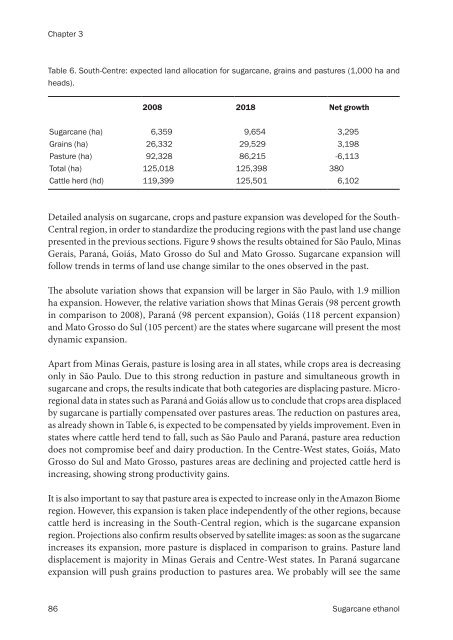Sugarcane ethanol: Contributions to climate change - BAFF
Sugarcane ethanol: Contributions to climate change - BAFF
Sugarcane ethanol: Contributions to climate change - BAFF
Create successful ePaper yourself
Turn your PDF publications into a flip-book with our unique Google optimized e-Paper software.
Chapter 3<br />
Table 6. South-Centre: expected land allocation for sugarcane, grains and pastures (1,000 ha and<br />
heads).<br />
2008 2018 Net growth<br />
<strong>Sugarcane</strong> (ha) 6,359 9,654 3,295<br />
Grains (ha) 26,332 29,529 3,198<br />
Pasture (ha) 92,328 86,215 -6,113<br />
Total (ha) 125,018 125,398 380<br />
Cattle herd (hd) 119,399 125,501 6,102<br />
Detailed analysis on sugarcane, crops and pasture expansion was developed for the South-<br />
Central region, in order <strong>to</strong> standardize the producing regions with the past land use <strong>change</strong><br />
presented in the previous sections. Figure 9 shows the results obtained for São Paulo, Minas<br />
Gerais, Paraná, Goiás, Ma<strong>to</strong> Grosso do Sul and Ma<strong>to</strong> Grosso. <strong>Sugarcane</strong> expansion will<br />
follow trends in terms of land use <strong>change</strong> similar <strong>to</strong> the ones observed in the past.<br />
�e absolute variation shows that expansion will be larger in São Paulo, with 1.9 million<br />
ha expansion. However, the relative variation shows that Minas Gerais (98 percent growth<br />
in comparison <strong>to</strong> 2008), Paraná (98 percent expansion), Goiás (118 percent expansion)<br />
and Ma<strong>to</strong> Grosso do Sul (105 percent) are the states where sugarcane will present the most<br />
dynamic expansion.<br />
Apart from Minas Gerais, pasture is losing area in all states, while crops area is decreasing<br />
only in São Paulo. Due <strong>to</strong> this strong reduction in pasture and simultaneous growth in<br />
sugarcane and crops, the results indicate that both categories are displacing pasture. Microregional<br />
data in states such as Paraná and Goiás allow us <strong>to</strong> conclude that crops area displaced<br />
by sugarcane is partially compensated over pastures areas. �e reduction on pastures area,<br />
as already shown in Table 6, is expected <strong>to</strong> be compensated by yields improvement. Even in<br />
states where cattle herd tend <strong>to</strong> fall, such as São Paulo and Paraná, pasture area reduction<br />
does not compromise beef and dairy production. In the Centre-West states, Goiás, Ma<strong>to</strong><br />
Grosso do Sul and Ma<strong>to</strong> Grosso, pastures areas are declining and projected cattle herd is<br />
increasing, showing strong productivity gains.<br />
It is also important <strong>to</strong> say that pasture area is expected <strong>to</strong> increase only in the Amazon Biome<br />
region. However, this expansion is taken place independently of the other regions, because<br />
cattle herd is increasing in the South-Central region, which is the sugarcane expansion<br />
region. Projections also con�rm results observed by satellite images: as soon as the sugarcane<br />
increases its expansion, more pasture is displaced in comparison <strong>to</strong> grains. Pasture land<br />
displacement is majority in Minas Gerais and Centre-West states. In Paraná sugarcane<br />
expansion will push grains production <strong>to</strong> pastures area. We probably will see the same<br />
86 <strong>Sugarcane</strong> <strong>ethanol</strong>












